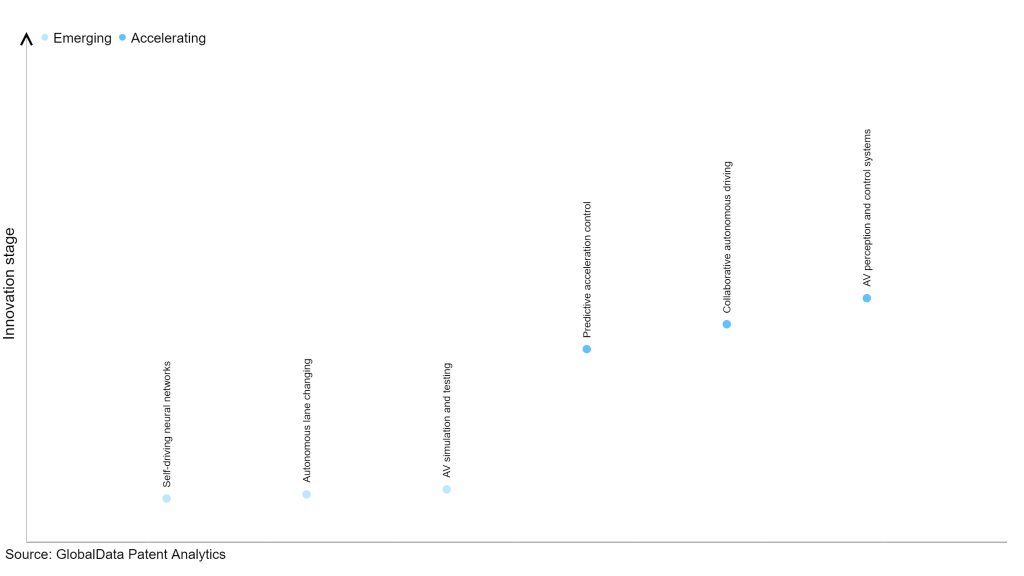The automotive industry continues to be a hotbed of patent innovation. Activity is driven by factors such as growing demand for autonomous vehicles (AVs), the need for a safe and seamless transition from autonomous to manual driving as AVs are not yet capable of operating safely in all situations, technological innovations, and increasing government regulations to development and deployment of AVs, as well as growing importance of technologies such as sensors, vehicle-to-vehicle (V2V) communication, vehicle to infrastructure (V2I) communication and functional safety. In the last three years alone, there have been over 720,000 patents filed and granted in the automotive industry, according to GlobalData’s report on Artificial intelligence in automotive: autonomous-to-manual switching. Buy the report here.
However, not all innovations are equal and nor do they follow a constant upward trend. Instead, their evolution takes the form of an S-shaped curve that reflects their typical lifecycle from early emergence to accelerating adoption, before finally stabilizing and reaching maturity.
Identifying where a particular innovation is on this journey, especially those that are in the emerging and accelerating stages, is essential for understanding their current level of adoption and the likely future trajectory and impact they will have.
300+ innovations will shape the automotive industry
According to GlobalData’s Technology Foresights, which plots the S-curve for the automotive industry using innovation intensity models built on over one million patents, there are 300+ innovation areas that will shape the future of the industry.
Within the emerging innovation stage, self-driving neural networks, autonomous lane changing and AV simulation and testing are disruptive technologies that are in the early stages of application and should be tracked closely. Predictive acceleration control, collaborative autonomous driving, and AV perception and control systems are some of the accelerating innovation areas, where adoption has been steadily increasing.
Innovation S-curve for artificial intelligence in the automotive industry

Autonomous-to-manual switching is a key innovation area in artificial intelligence
Autonomous-to-manual switching refers to the ability of a vehicle to transition between autonomous driving mode and manual driving mode, and the associated hardware and software systems that enable the transition.
GlobalData’s analysis also uncovers the companies at the forefront of each innovation area and assesses the potential reach and impact of their patenting activity across different applications and geographies. According to GlobalData, there are 110+ companies, spanning technology vendors, established automotive companies, and up-and-coming start-ups engaged in the development and application of autonomous-to-manual switching.
Key players in autonomous-to-manual switching – a disruptive innovation in the automotive industry
‘Application diversity’ measures the number of applications identified for each patent. It broadly splits companies into either ‘niche’ or ‘diversified’ innovators.
‘Geographic reach’ refers to the number of countries each patent is registered in. It reflects the breadth of geographic application intended, ranging from ‘global’ to ‘local’.
Patent volumes related to autonomous-to-manual switching
Source: GlobalData Patent Analytics
Toyota Motor is one of the leading patent filers in autonomous-to-manual switching. Toyota is currently developing new algorithms for its autonomous-to-manual switching (AMS) systems, which are more accurate and efficient than traditional AMS algorithms. These new algorithms are designed to better perceive the surrounding environment and make decisions about when and how to switch from autonomous to manual driving. Toyota is also utilizing new sensors and sensor fusion technologies to further improve the performance of its AMS systems. Some other key patent filers in the space include Hyundai Motor, Kia, and Honda Motor
In terms of application diversity, NSK leads the pack, while Cartica and ResMed stood in the second and third positions, respectively. By means of geographic reach, Intel held the top position, followed by Alphabet and Tata Motors.
To further understand the key themes and technologies disrupting the automotive industry, access GlobalData’s latest thematic research report on Artificial Intelligence (AI) in Automotive.
Data Insights
From

The gold standard of business intelligence.
Blending expert knowledge with cutting-edge technology, GlobalData’s unrivalled proprietary data will enable you to decode what’s happening in your market. You can make better informed decisions and gain a future-proof advantage over your competitors.



